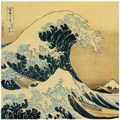Hokusai: Difference between revisions
(Created page with "<html><div class="mw-content-ltr" dir="ltr" id="mw-content-text" lang="en"><p><b>Katsushika Hokusai</b> (1760-1849) was born in Edo (now Tokyo). A prolific artist, he painted, designed prints, illustrated books and is one of the masters of the Japanese Print (Ukiyo-E). </p><p>His work is a major influence on nearly all of Japan's traditional <a href="/index.php?title=Tattoo" title="Tattoo">tattoo</a> movement with many of his stylistic interpretations instantly recogniza...") |
(Page conversion via llm-mediawiki-rev -jwm) |
||
| Line 1: | Line 1: | ||
'''Katsushika Hokusai''' (1760-1849) was born in Edo (now Tokyo). A prolific artist, he painted, designed prints, illustrated books and is one of the masters of the Japanese Print (Ukiyo-E). | |||
His work is a major influence on nearly all of Japan's traditional [[Tattoo|tattoo]] movement with many of his stylistic interpretations instantly recognizable. | |||
< | He was one of the first major Japanese artists to break away from urban scenes and produce landscapes, and in keeping with his unorthodoxy he turned to the west for influence. He was an admirer of the French painter Manet and they enjoyed a relationship of mutual learning with each other, Hokusai teaching Manet by example and Manet sending blue inks that were not available in Japan in return (see "Beneath the wave off Kanagawa," below). | ||
<gallery> | |||
File:Hokusai.jpg|Hokusai's most famous work "Beneath the wave off Kanagawa" showing what was to become "typical" Japanese tattoo style water. This is also the blue ink that was sent to him by Manet. | |||
File:HokusaiWaveTat.jpg|Tattoo literally based on Hokusai's work. | |||
</gallery> | |||
Latest revision as of 05:03, 17 September 2023
Katsushika Hokusai (1760-1849) was born in Edo (now Tokyo). A prolific artist, he painted, designed prints, illustrated books and is one of the masters of the Japanese Print (Ukiyo-E).
His work is a major influence on nearly all of Japan's traditional tattoo movement with many of his stylistic interpretations instantly recognizable.
He was one of the first major Japanese artists to break away from urban scenes and produce landscapes, and in keeping with his unorthodoxy he turned to the west for influence. He was an admirer of the French painter Manet and they enjoyed a relationship of mutual learning with each other, Hokusai teaching Manet by example and Manet sending blue inks that were not available in Japan in return (see "Beneath the wave off Kanagawa," below).

